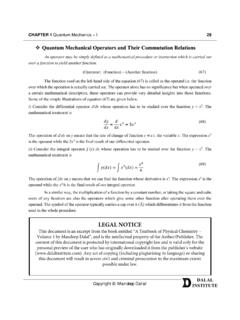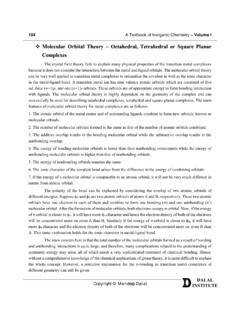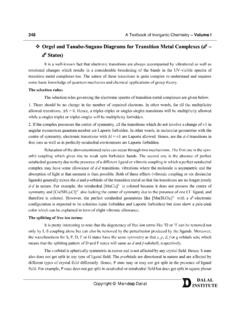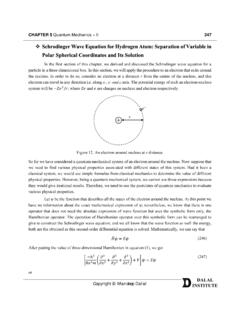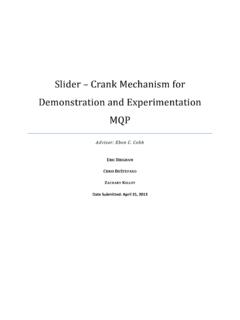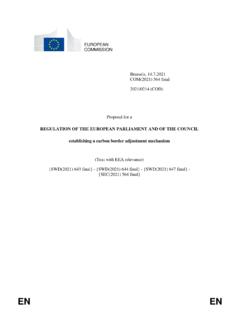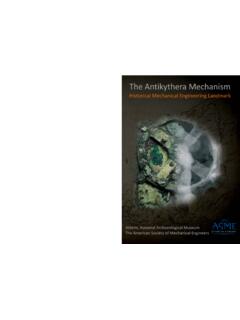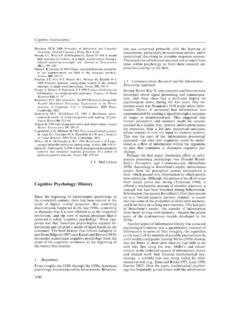Transcription of Mechanism of Electron Transfer Reactions – Types; Outer ...
1 106 A Textbook of Inorganic Chemistry Volume I. Mechanism of Electron Transfer Reactions Types; Outer Sphere Electron Transfer Mechanism and Inner Sphere Electron Transfer Mechanism The process of Electron Transfer from one species to another species leads to the oxidation of the donor and the reduction of the acceptor. The Electron donor acts as the reducing agent and called as reductant while the Electron acceptor acts as the oxidizing agent and called as the oxidant. We have already studied the redox reaction of simple species like: Na + Cl Na+ + Cl (8). However, the ligand displacement Reactions , we have studied so far, do not involve any change in the oxidation state of the metal center but the substitution Reactions involving the Electron Transfer between complex species do exist.
2 The oxidation-reduction reaction may or may not occur through the net chemical change. A simple example of Electron Transfer between complex species can be given as: [Fe(H2 O)6 ]2+ + [Fe (H2 O)6 ]3+ [Fe(H2 O)6 ]3+ + [Fe (H2 O)6 ]2+ (9). The Mechanism by which the Electron Transfer occurs in transition metal complexes can be classified into two types as given below. Outer Sphere Electron Transfer Mechanism In this Mechanism , there is a direct Transfer of electrons from the reductant to oxidant and the coordination sphere remains intact. The ligands in both the reactants remain as such and the bond making or bond-breaking does not take place. In other words, the complexes do not undergo ligand substitution and no new bonds are formed or broken.
3 Consider the following example. [Cr(H2 O)6 ]2+ + [Co(H2 O)6 ]3+ [Cr(H2 O)6 ]3+ + [Co(H2 O)6 ]2+ (10). If R is the reductant and O is the oxidant, the Outer sphere Electron Transfer can be shown as: LEGAL NOTICE. This document is an excerpt from the book entitled A Textbook of Inorganic Chemistry Volume 1 by Mandeep Dalal , and is the intellectual property of the Author/Publisher. The content of this document is protected by international copyright law and is valid only for the personal preview of the user who has originally downloaded it from the publisher's website ( ). Any act of copying (including plagiarizing its language) or sharing this document will result in severe civil and criminal prosecution to the maximum extent possible under law.
4 Copyright Mandeep Dalal CHAPTER 4 Reaction Mechanism of Transition Metal Complexes II: 107. It has been observed that the formation of precursor complex and the dissociation of the successor complex is very fast but the Electron Transfer is quite slow. The course of the complete reaction is shown below. Figure 15. The general reaction coordinate diagram for the Mechanism involved Outer -sphere Electron Transfer Reactions . In the transition state of the complex, the electrons have equal probability to be present on either of the metal center. In order to proceed further, we need to recall the concept of inert and labile complexes first. Inert Complexes Labile Complexes d3, d4 LS, d5 LS, d6 LS, d8 d0, d1, d2, d4 HS, d5 HS, d7, d6 HS, d9, d10.
5 It is worth remembering that low-spin complexes are generally formed by the strong field ligands like CO, PR3, CN or by the transition metal ions from 2nd and 3rd transition series. Co(III) complexes are also generally low spin in nature. On the other hand, high-spin complexes are generally formed by the weak field ligands like H2O, NH3, Cl or by the transition metal ions of 1st transition series. Co(II) complexes are also generally high- spin in nature. The overall activation energy and hence the rate dependence of Outer -sphere Electron Transfer Reactions can be given as: . G = Gt + GO + Gi (11). Where Buy the complete book with TOC navigation, Copyright Mandeep Dalal high resolution images and no watermark.
6 108 A Textbook of Inorganic Chemistry Volume I. i) Gt* is the energy required to bring the reactant molecules closer to each other against the Coulombic repulsion. ii) Go* is the energy required to reorganize the solvent molecules. As the solvent interactions like H-bonding with the complex molecules increase, the rate of the reaction decreases. On the other hand, solvents with less or no interaction will increase the reaction rate. Figure 16. The solvent reorganization during the formation of the precursor complex. iii) Gi* is energy required for the reorganization of various bond lengths to make the interacting orbitals of the approximately same energy.
7 This can be explained in terms of the Frank-Condon principle which states that the electronic transitions occur at a much faster rate than the nuclei can respond. Now as we know that the metal-ligand bond lengths are highly dependent on the oxidation state of the metal center, it is pretty obvious that complexes must adjust their bond lengths for the Electron Transfer to occur. Buy the complete book with TOC navigation, Copyright Mandeep Dalal high resolution images and no watermark. CHAPTER 4 Reaction Mechanism of Transition Metal Complexes II: 109. (a). (b). Figure 17. Formation of (a) internal reorganization and (b) corresponding ligand field splitting.
8 Buy the complete book with TOC navigation, Copyright Mandeep Dalal high resolution images and no watermark. 110 A Textbook of Inorganic Chemistry Volume I. The main factors affecting the Outer sphere Electron Transfer are: 1. Orbital Symmetry: Electron Transfer Outer -sphere Mechanism requires orbital overlap and occurs between orbitals of the same symmetry. Figure 18. The Electron Transfer in eg eg ( * *) transition. In the octahedral fields, eg eg ( * *) transition requires a large change in bond lengths and orbital overlap is also very small due to the ligand steric. This results in an Electron Transfer at a very slow rate. On the other side, t2g t2g ( / * / *) transition involves a small change in bond lengths and the orbital overlap is also very good which depends upon the nature of the ligands.
9 This results in an Electron Transfer at a very fast rate. (a) (b). Figure 19. The Electron Transfer in (a) eg eg ( * *) transitions is having poor overlap; while (b) the t2g t2g ( / * / *) transitions involve batter overlap. Buy the complete book with TOC navigation, Copyright Mandeep Dalal high resolution images and no watermark. CHAPTER 4 Reaction Mechanism of Transition Metal Complexes II: 111. 2. Orbital Overlap: It has been observed that Outer -sphere Electron Transfer is generally faster for 2nd and 3rd transition series metal ion than that 1st which can be explained in terms of batter overlap of 4d and 5d orbitals as compared to the 3d one. Moreover, the stronger crystal field also results in less bond length distortion.
10 Ligands with extended -system also speed up the Transfer rate. (a) (b). Figure 20. Ligands with extended -conjugation supporting orbital overlap (a) 1,10-phenanthroline (b). 2,2'-bipyridine. 3. Electronic Configuration: If the Electron Transfer occurs through a change in electronic configuration (high-spin to low-spin or low-spin to high-spin), the activation energy barrier will be very high and a slow Electron Transfer is expected. In another view, Electron reorganization induces a large change in bond lengths and hence slows down the rate of Electron Transfer . Figure 21. The Electron Transfer phenomena in transitions involving a reorganisation of electronic configuration.


